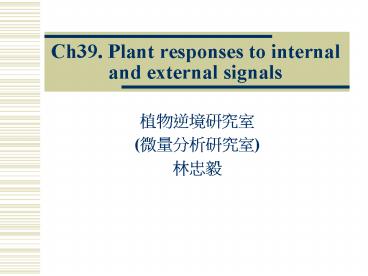Ch39' Plant responses to internal and external signals PowerPoint PPT Presentation
1 / 45
Title: Ch39' Plant responses to internal and external signals
1
Ch39. Plant responses to internal and external
signals
- ???????
- (???????)
- ???
2
Plant responses to internal and external signals
- Signal transduction
- Plant hormones
- Responses to light
- Variety of stimuli
- Herbivores and pathogens
3
Signal transduction
- Signal transduction pathway link signal reception
to response - 1. Reception
- 2. Transduction
- 3. Response
4
(No Transcript)
5
(No Transcript)
6
(No Transcript)
7
The role of phytochrome in de-etiolation response
8
Response
- They are two main mechanisms by which a signaling
pathway can activate an enzymes - 1. Stimulating transcription of mRNA for the
enzyme - 2. Activating existing enzyme molecules
9
Transcription of mRNA for example of
de-etiolation
- Transcriptional regulation activation of some
transcription factors - Post-transcriptional modification of proteins
phosphorylation - De-etiolation proteins include enzymes for
photosynthesis directly, others are enzymes
involved chlorophyll production
10
Plant hormones
- Plant hormones help coordinate growth,
development, and responses to stimuli - 1. The discovery of plant hormones
- 2. A survey of plant hormones
11
- Phototropism
12
Phototropism and growth-promoting chemical
Asymmetric distribution of a growth-promoting
chemical cause a coleoptile to growth toward the
light
13
Where production and function of hormone
14
Auxins
Cell elongation Lateral and adventitious root
formation Auxins as herbicide
15
Polar movement of auxin
16
Cell elongation in response to auxin the acid
growth hypothesis
17
Cytokinins
- Control of cell division and differentiation
- Control of apical dominance
- Anti-aging effect
18
Cytokinins
Control of Apical dominance
19
Gibberellins
- Stem elongation
- Fruit growth
- Germination
20
(No Transcript)
21
(No Transcript)
22
Brassinosteroids
- Induce cell division and elongation in stem and
seedling - Retard leaf abscission and promote xylem
differentiation
23
Abscisic acid
- Seed Dormancy
- Drought tolerance
24
Ethylene
- The triple response to mechanical stress
- Apoptosis programmed cell death
- Fruit ripening
25
The triple response
26
- The triple response
27
Ethylene signal transduction mutant
28
Abscission of a maple leaf
29
Responses to light
- Responses to light are critical for plant
success photomorphogenesis and action spectrum - 1. Blue-light photoreceptor
- 2. Phytochromes as photoreceptor
- 3. Biological clocks and circadian rhythms
- 4. The effect of light on the biological clock
- 5. Photoperiodism and responses to seasons
30
Action spectrum
31
Red and far-red illumination affect seed
germination
32
Phytochrome a molecular switching mechanism
33
Biological clocks and circadian rhythms
34
The effect of light on the biological clock
- Phytoperiodism and control of flowering
- Short-day plant required a light period shorter
than a critical length to flower - long-day plant required a light period longer
than a critical length to flower - Day-neutral plant unaffected by photoperiod and
flower when reaching a certain stage of maturity - Vernalization use of pretreatment with cold to
induce flowering
35
(No Transcript)
36
- Florigen the flowering signal, not yet
chemically identified
37
Variety of stimuli
- Plants respond to a wide variety of stimuli other
than light - 1. Gravity
- 2. Mechanical stimuli
- 3. Environmental stresses
38
Gravitropism
39
Thigmomorphogenesis the changes in form
that result from mechanical perturbation
Rubbing the stems of a Arabidopsis young plant a
couple of times daily results in plants that are
shorter than control
40
Touch specialists
Thigmotropism Most veins have tendrils that
coiling rapidly around support. These grasping
organs usually growth stright until they touch
something Other example of touch specialists are
plants that undergo rapid leaf movements in
response to mechanical stimulation
41
Enviromental stresses
- Dought
- Flooding
- Salt stress
- Heat stress
- Cold stress
42
Herbivores and pathogens
- Plants defend themselves against herbivores and
pathogens - 1. Defenses against herbivores recruit predatory
animals - 2. Defenses against pathogens gene-for-gene
recognition, plant responses to pathogen
invasion, and systemic acquired resistance
43
Defenses against herbivores recruit predatory
animals
44
Defenses against pathogens Gene-for-gene
recognition
45
Defense responses elicitors, phytoalexins, PR
(pathogenesis-related)proteins, hypersensitive
response

